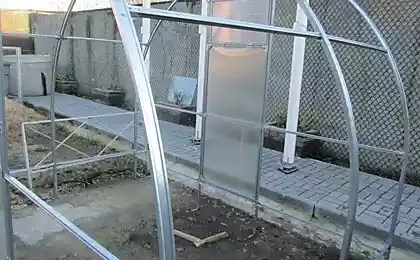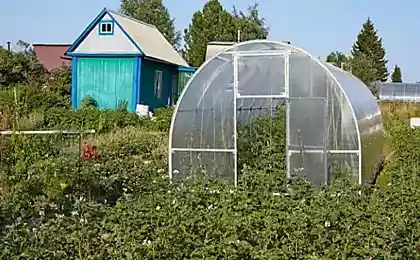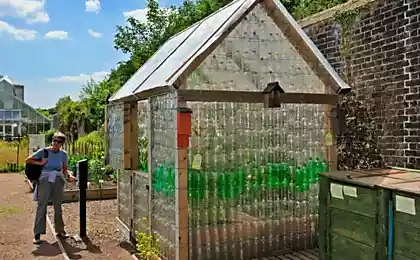1312
35 underground greenhouse for year-round cultivation
At different latitudes we have a different temperature of the surface air, but the temperature at a depth of 1.5-2.5 m remains unchanged — 10-15 degrees. The indicators inside your greenhouse will be the better, the deeper you plant it in the ground.


This underground greenhouse in Spetchley Gardens, UK. The entrance is seen to the right

Underground greenhouse inside can be finished with stone, mud bricks (Adobe) or any dense natural material able to absorb large amount of heat. Plants resistant to cold weather conditions crops such as lettuce, cabbage and broccoli. The glazing creates a "greenhouse effect". You will hardly be able to build a greenhouse, if you have a high groundwater level. Such a greenhouse you can build at least 1.5 m above the groundwater level.

This is the principle of operation of underground greenhouses Mike Ohler. Mike digs a trench on the South side that allows cool air to descend and warm up in the warm soil. Install a pipe in the ground to transfer the heated air to the ground.

And this kind of underground greenhouses Alpine, which build the Indians in the mountains of South America (translated from the Indian, walipini means "place of warmth"). When digging the upper layer of soil laid on the bottom of the greenhouse, the rest is used as the new shaft on the North side. Window exposed with an angle of 90 degrees to the sun at the winter solstice, this will allow the greenhouse to keep the most warmth in those days, when the sun is shining less hours.

This scheme is an underground greenhouse made of bags filled with earth. Bags accumulate heat during the day to give during the night. Properly designed underground greenhouse is naturally heated from five sides, unlike the above-ground greenhouses, where it is heated only one side — the floor throughout the day. Along the walls of the greenhouse must to do a waterproof barrier.

Another view of underground greenhouses from Barbara and Ken Kern.

This greenhouse is lined with local stone in Nepal at an altitude of almost 3,000 metres above sea level where the temperatures drop below freezing 199 days per year. Inside the lush vegetation.

This underground greenhouse is made in Mongolia, the performance — within three seasons. As shown by the traces, and the entrance is on the opposite side.
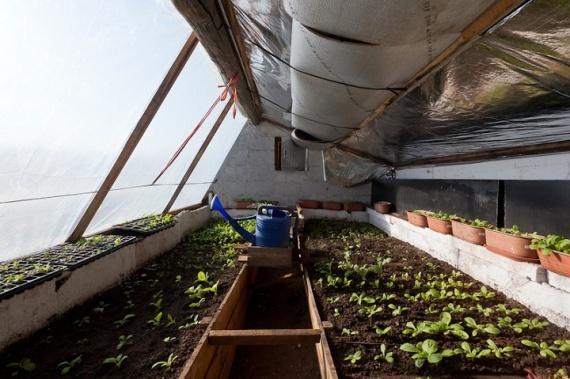
View from the inside. In cold climates the Northern, Eastern and Western walls must be well insulated. In the North, the ceiling should also be well insulated.

This greenhouse is built on a hill in Tennessee, USA.
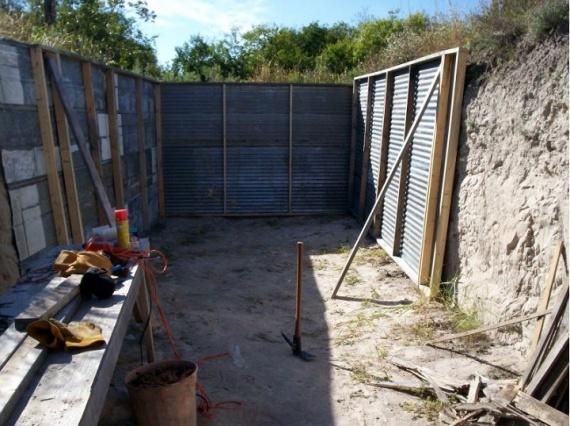
The pit for the underground greenhouses are dug in Texas. The earth is solid and it does not strengthen.

It earth greenhouse in Patagonia. Bags form a wall, and the film goes further in protecting them from moisture.

You can dig a shallow drainage ditch around the perimeter of the greenhouse, to divert rainwater.

Sometimes placed in the greenhouse tanks with rain water, to store more heat. Note the vestibule for the entrance on the right.
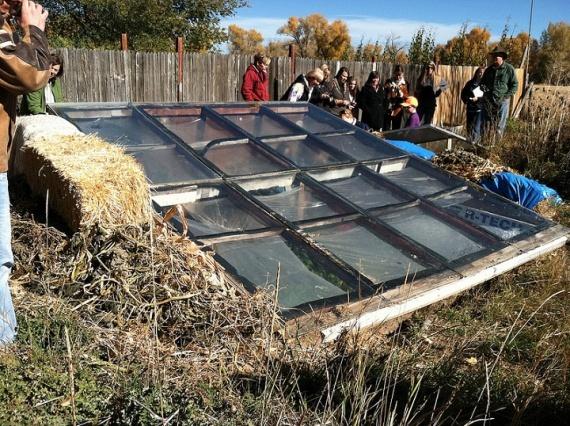
This Alpine greenhouse made from old Windows.

Walipini greenhouse in Ladakh, built of mud bricks, the performance — all year round in very harsh climates.

Care must be taken when waterproofing, drainage and ventilation of underground greenhouses. The most effective underground greenhouse with Windows on the South and a wall to the North to keep warm. In this greenhouse punched hole for irrigation, the water does not freeze.

The couple bought a house with an old pool and turned it into "urban greenhouse".

This clay greenhouse made in Poland.
2 the most important factor in the design of the underground greenhouse

The easiest way to warm and bring light into the basement. To build an underground mini-greenhouse on the South side of your home.

Underground greenhouse used as a dining room
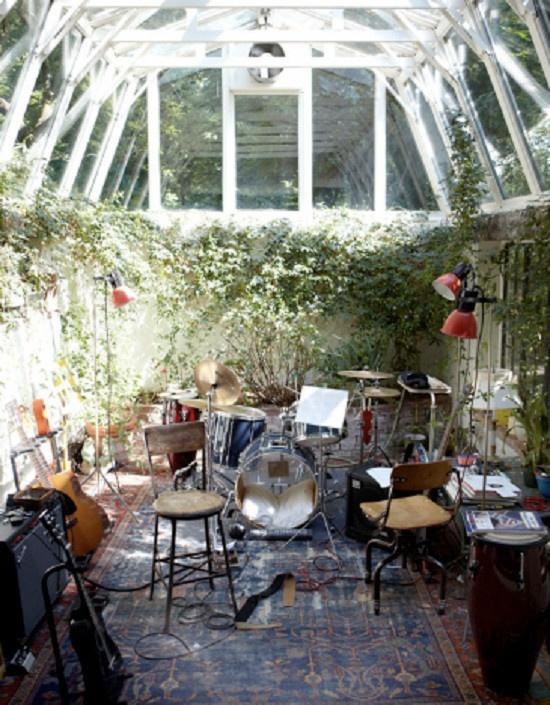
But if in the greenhouse, good acoustics, you can make a Studio

This underground greenhouse of the Institute of New AIchemy. Here placed next to a pond, compost heap, greenhouse and home. The water is dense and holds heat even better than the stone, the soil takes the third place in heat preservation. Ponds used for irrigation of crops.

Underground greenhouse on an organic farm in Wisconsin. The larger the size of your greenhouse, the more effective it is, as the temperature inside the small greenhouse can fluctuate quite quickly.

This underground greenhouse on 850 sq. m. lined with straw bales in Wisconsin.

Underground greenhouse Hiroshi Iguchi, Japan. It is obvious that the greenhouse is not completely closed.
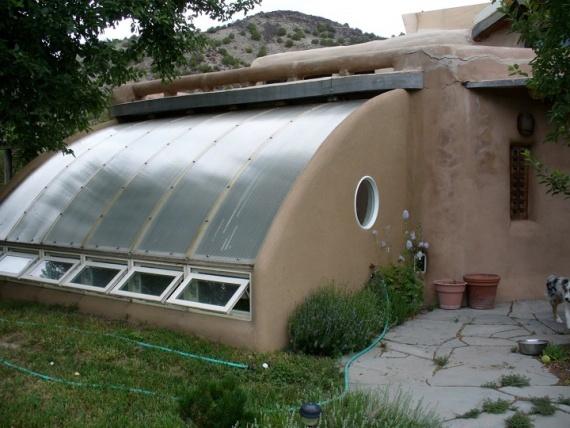
Here is another greenhouse made of clay and straw from new Mexico.

Wall underground greenhouse.

Semi-underground greenhouse surrounded on two sides by a stone wall and earth behind.

Underground greenhouse embedded into the hill

Underground greenhouses attached to stone buildings are also extremely energy efficient!

Straw are a great insulator (R-value 1.5 to 3 per inch). Manure under the ground will also help keep warm for plants.

Frame from old Windows and straw bales. At the bottom lie the manure or compost under a layer of fertile soil, it will help to keep warm.published
P. S. And remember, only by changing their consumption — together we change the world! ©
Join us in Facebook , Vkontakte, Odnoklassniki
Source: www.pervorod.ru/blogs/eto-interesno/35-podzemnyh-teplits-dlya-kruglogodichnogo-vyraschivaniya


This underground greenhouse in Spetchley Gardens, UK. The entrance is seen to the right

Underground greenhouse inside can be finished with stone, mud bricks (Adobe) or any dense natural material able to absorb large amount of heat. Plants resistant to cold weather conditions crops such as lettuce, cabbage and broccoli. The glazing creates a "greenhouse effect". You will hardly be able to build a greenhouse, if you have a high groundwater level. Such a greenhouse you can build at least 1.5 m above the groundwater level.

This is the principle of operation of underground greenhouses Mike Ohler. Mike digs a trench on the South side that allows cool air to descend and warm up in the warm soil. Install a pipe in the ground to transfer the heated air to the ground.

And this kind of underground greenhouses Alpine, which build the Indians in the mountains of South America (translated from the Indian, walipini means "place of warmth"). When digging the upper layer of soil laid on the bottom of the greenhouse, the rest is used as the new shaft on the North side. Window exposed with an angle of 90 degrees to the sun at the winter solstice, this will allow the greenhouse to keep the most warmth in those days, when the sun is shining less hours.

This scheme is an underground greenhouse made of bags filled with earth. Bags accumulate heat during the day to give during the night. Properly designed underground greenhouse is naturally heated from five sides, unlike the above-ground greenhouses, where it is heated only one side — the floor throughout the day. Along the walls of the greenhouse must to do a waterproof barrier.

Another view of underground greenhouses from Barbara and Ken Kern.

This greenhouse is lined with local stone in Nepal at an altitude of almost 3,000 metres above sea level where the temperatures drop below freezing 199 days per year. Inside the lush vegetation.

This underground greenhouse is made in Mongolia, the performance — within three seasons. As shown by the traces, and the entrance is on the opposite side.

View from the inside. In cold climates the Northern, Eastern and Western walls must be well insulated. In the North, the ceiling should also be well insulated.

This greenhouse is built on a hill in Tennessee, USA.

The pit for the underground greenhouses are dug in Texas. The earth is solid and it does not strengthen.

It earth greenhouse in Patagonia. Bags form a wall, and the film goes further in protecting them from moisture.

You can dig a shallow drainage ditch around the perimeter of the greenhouse, to divert rainwater.

Sometimes placed in the greenhouse tanks with rain water, to store more heat. Note the vestibule for the entrance on the right.

This Alpine greenhouse made from old Windows.

Walipini greenhouse in Ladakh, built of mud bricks, the performance — all year round in very harsh climates.

Care must be taken when waterproofing, drainage and ventilation of underground greenhouses. The most effective underground greenhouse with Windows on the South and a wall to the North to keep warm. In this greenhouse punched hole for irrigation, the water does not freeze.

The couple bought a house with an old pool and turned it into "urban greenhouse".

This clay greenhouse made in Poland.
2 the most important factor in the design of the underground greenhouse
- a large amount of thermal mass (rocks, soil, water),
- positioning towards the sun.

The easiest way to warm and bring light into the basement. To build an underground mini-greenhouse on the South side of your home.

Underground greenhouse used as a dining room

But if in the greenhouse, good acoustics, you can make a Studio

This underground greenhouse of the Institute of New AIchemy. Here placed next to a pond, compost heap, greenhouse and home. The water is dense and holds heat even better than the stone, the soil takes the third place in heat preservation. Ponds used for irrigation of crops.

Underground greenhouse on an organic farm in Wisconsin. The larger the size of your greenhouse, the more effective it is, as the temperature inside the small greenhouse can fluctuate quite quickly.

This underground greenhouse on 850 sq. m. lined with straw bales in Wisconsin.

Underground greenhouse Hiroshi Iguchi, Japan. It is obvious that the greenhouse is not completely closed.

Here is another greenhouse made of clay and straw from new Mexico.

Wall underground greenhouse.

Semi-underground greenhouse surrounded on two sides by a stone wall and earth behind.

Underground greenhouse embedded into the hill

Underground greenhouses attached to stone buildings are also extremely energy efficient!

Straw are a great insulator (R-value 1.5 to 3 per inch). Manure under the ground will also help keep warm for plants.

Frame from old Windows and straw bales. At the bottom lie the manure or compost under a layer of fertile soil, it will help to keep warm.published
P. S. And remember, only by changing their consumption — together we change the world! ©
Join us in Facebook , Vkontakte, Odnoklassniki
Source: www.pervorod.ru/blogs/eto-interesno/35-podzemnyh-teplits-dlya-kruglogodichnogo-vyraschivaniya

